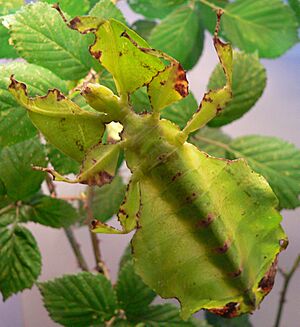Pulchriphyllium bioculatum facts for kids
Quick facts for kids Pulchriphyllium bioculatum |
|
|---|---|
 |
|
| A female Pulchriphyllium bioculatum | |
| Conservation status | |
| Scientific classification | |
| Genus: |
Pulchriphyllium
|
| Species: |
bioculatum
|
| Subspecies | |
|
|
| Synonyms | |
|
|
The Pulchriphyllium bioculatum, also known as the Seychelles leaf insect, Javanese leaf insect, or Gray's leaf insect, is a fascinating insect that looks just like a leaf! It belongs to the Phylliidae family. You can find these amazing creatures in warm, tropical parts of Asia, as well as on islands like Madagascar, Mauritius, and the Seychelles.
This leaf insect was first described by a scientist named George Robert Gray in 1832. It was the very first phasmid (a group of insects that includes stick insects and leaf insects) that he discovered. Leaf insects have very flat bodies, wings, and legs that are shaped like leaves. They usually grow to be about 5 to 10 centimeters (2 to 4 inches) long. They get their name because their large, tough front wings have veins that look just like the veins on the leaves they live on. The scientific name bioculatum means "two-eyed." This refers to two small dots found on their abdomen (the back part of their body).
Contents
What Does It Look Like?
This insect has a green, wide body and legs. It often has spots too. Both male and female leaf insects can be green, yellow, or even orange. Adult Javanese leaf insects are usually greenish or brownish. Males are typically 6.6 to 9.4 centimeters (2.6 to 3.7 inches) long.
Their front wings and amazing camouflage help them hide from enemies. Female leaf insects have very short antennae, while males have longer ones. Adult females are about 4.5 to 6.9 centimeters (1.8 to 2.7 inches) long. Males can fly using their back wings, but females do not fly.
When they are young, Pulchriphyllium bioculatum are about 2 centimeters (0.8 inches) long and are dark red. They can also stay very still to avoid being seen. These insects shed their skin, called molting, about 5 to 6 times during their life. Females are heavier and cannot fly. Each female can lay around 500 eggs in her lifetime. The base of their abdomen is narrower, and the upper part of their front legs is wider.
How They Live and Protect Themselves
Leaf insects are slow-moving herbivores, which means they only eat plants. They depend on their incredible camouflage and front wings to hide from predators. These predators include birds, amphibians (like frogs), and reptiles (like lizards).
Female leaf insects usually live for 4 to 7 months. Males have a shorter life, living for about 3 weeks to 1 month.
Where Do They Live?
These leaf insects mostly live in tropical areas and rainforests. These places have plenty of plants for them to eat. You can find them across Southeast Asia, including Borneo, China, India, Sri Lanka, Java, Malaysia, Singapore, and Sumatra. They are also found in Madagascar, Mauritius, and the Seychelles. However, some scientists believe they are only truly native to the Seychelles, and other sightings might be different species.
The best temperature for these insects is 24 to 28 degrees Celsius (75 to 82 degrees Fahrenheit). At night, the temperature can drop a little, by 2 to 3 degrees Celsius (3 to 5 degrees Fahrenheit). The temperature doesn't affect them too much, but if it's too cold (below 22 degrees Celsius or 72 degrees Fahrenheit), their development will slow down. It's also important that the air isn't too dry, as low humidity can make them stressed or even die.
What Do They Eat?
Since Pulchriphyllium bioculatum are plant-eaters, they mainly munch on leaves from plants like mango, guava, and Nephelium lappaceum (which is also called Rambutan). If they are kept as pets, they might also eat leaves from Quercus (oak) and Rubus (like dewberry, raspberry, and blackberry) plants.
A study in Sri Lanka looked at what these leaf insects eat. The insects mostly ate guava leaves. Because of this, the local name for the species in Sri Lanka is pera kolaya, which means "guava leaf." In many places, people call them by names related to what they eat.
Reproduction and Life Cycle
Female leaf insects lay their eggs over several months. The eggs usually take 5 to 7 months to hatch if kept at 25 degrees Celsius (77 degrees Fahrenheit). The eggs are beige-brown and about 6 to 7 millimeters (0.24 to 0.28 inches) long.
Sometimes, the eggs laid by females are not fertilized by a male. This is a special type of asexual reproduction called parthenogenesis. In this case, the baby insect develops from an egg without any help from a male. These eggs are oval or barrel-shaped, looking a lot like seeds.
Leaf insects have different ways of laying eggs. This species actually flicks its eggs away with a backward movement of its abdomen. One study found that they can throw their eggs a distance 24 to 36 times their own body length!
If the eggs are fertilized by a male, they hatch in about 3 to 4 months. If they are not fertilized, it takes longer, about 6 months, and only female insects will hatch from these eggs. Fertilized eggs can hatch into either male or female insects. A female leaf insect lays about 100 eggs, a few days apart. When the baby insects hatch, they are red, but they turn green within three to seven days.



